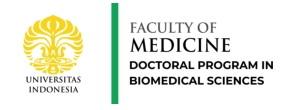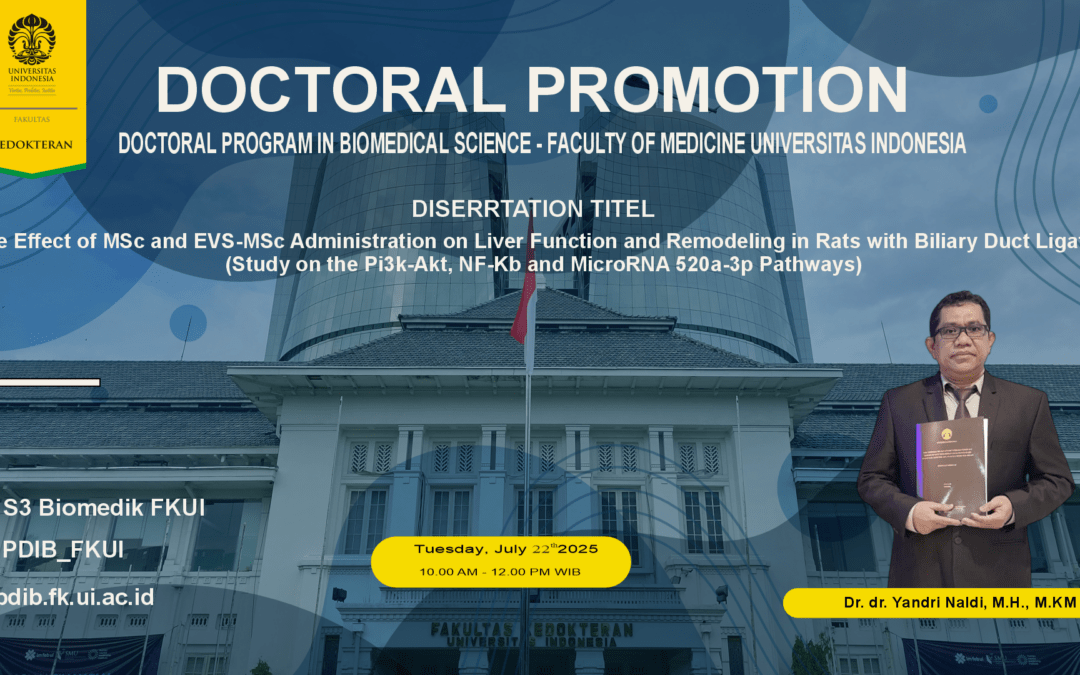Jakarta, July 22, 2025. Bile duct disorders in infants are a serious condition that can lead to severe liver damage and even liver failure if not treated properly.Recent research by Yandri Naldi presents a future therapeutic approach through a combination of mesenchymal stem cells (MSCs) and extracellular vesicles (EVs), also known as exosomes. Exosomes are small, nanometer-sized vesicles released by mesenchymal stem cells taken from umbilical cord tissue (Wharton’s jelly), which are then preconditioned with patient serum to function optimally according to the patient’s individual condition. Yandri Naldi’s research is funded by the University of Indonesia’s DIPA (International Indexed Publication) scheme (PUTI) Q1. Furthermore, Yandri Naldi’s doctoral education is funded by the Faculty of Medicine, Gunung Jati University, Cirebon, where he teaches.
Yandri Naldi’s research is the result of a close collaboration between the Department of Histology, Faculty of Medicine, University of Indonesia (FKUI), the Division of Pediatric Surgery, Department of Surgery, FKUI, Cipto Mangunkusumo Hospital (RSCM), and the Stem Cell and Tissue Engineering Research Center (SCTE-RC), a cluster under the Indonesia Medical Education and Research Institute (IMERI). This multidisciplinary collaboration combines expertise from pediatric surgery and biomedical sciences to study a combination therapy of MSCs and EVs in animal models using bile duct ligation (LDB), a procedure that involves severing the bile duct. The mice with LDB were injected with MSCs and EVs, and were directly treated by Dr. Rico Darmayanto Simorangkir, Sp.B., SubBPed, a pediatric surgeon with extensive experience in this field. Yandri Naldi’s research is a continuation of a series of previous studies that focused more on fundamental biomedical science, specifically to uncover the mechanisms of action of MSCs and EVs at the molecular level, particularly the role of miRNA in combination therapy using MSCs and EVs derived from mesenchymal stem cells derived from human umbilical cords.
The EVs were first conditioned with serum from patients with bile duct disorders, thus hopefully providing insight into the biological mechanisms underlying the effectiveness of EVS therapy. This in-depth scientific foundation is crucial to emphasize that the research is not merely about clinical application, but upholds the principles of basic research to find more targeted and personalized therapeutic solutions. “The study was conducted on liver samples from a mouse model that underwent bile duct ligation to mimic the conditions of bile duct disorders in humans. This combination therapy of MSCs and EVs successfully demonstrated improvements in liver tissue, including increased shape and function of damaged liver cells and improved fibrosis in the mouse livers. This combination therapy demonstrated a regenerative effect and improved liver fibrosis in the mice.
Various research methods were used in this study, ranging from examining EVs characteristics using a respiratory flow chip kit, particle size analyzer, zeta potential, and flow cytometry. These included hematoxylin-eosin staining, Masson trichrome, and immunohistochemistry, to sophisticated microarray examination to examine their microRNA.
Why is this study important? “Bile duct disorders are one of the leading causes of liver damage in infants, often requiring liver transplantation, a complex and limitedly accessible procedure. Effective and safe therapies are needed to improve liver function without the risk of invasive procedures. This combination therapy of MSCs and EVs offers new hope, offering a personalized and innovative approach to naturally repair liver tissue before patients can undergo a liver transplant.” Yandri Naldi said.
Key Findings by Yandri Naldi:
• Characterization of EVS-MSCs: EVs generated from umbilical cord stem cells, both naive and preconditioned using patient serum, were proven to be stable, pure, and have a specific molecular profile that supports therapeutic effectiveness.
• Rat model of bile duct obstruction: Administration of MSCs and EVs to rats with bile duct obstruction showed improved liver morphology with reduced tissue damage and increased liver cell regeneration, as well as improved liver function with increased expression of albumin and cytochrome P450.
• Comprehensive analysis methods: This study included characterization of naive MSC-MSC EVs and preconditioned MSC EVs, profiling miRNAs that regulate gene expression, and evaluation of liver tissue using microscopic and molecular biochemical techniques.
Yandri Naldi stated that this study presents a novelty through the use of MSC and EVS therapy that utilizes patient serum to increase the effectiveness and personalization of therapy. This approach is an innovation that has not been widely implemented.

